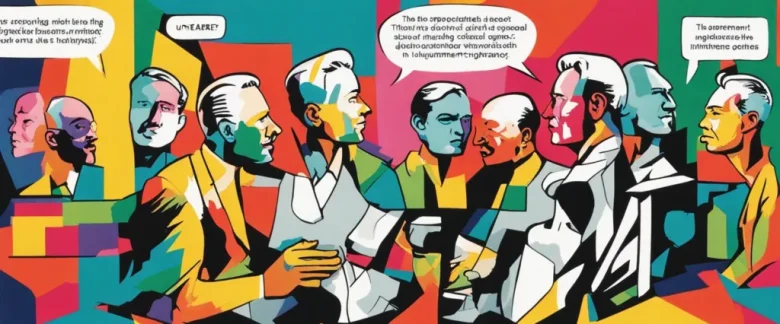In “Chatter,” Ethan Kross explores the fascinating realm of our inner voice and its impact on our lives. Through engaging anecdotes, scientific research, and practical techniques, Kross delves into the concept of “chatter” and its profound influence on our thoughts, emotions, and decision-making. As a renowned psychologist and Director of the Emotion and Self-Control Laboratory at the University of Michigan, Kross draws upon his expertise to shed light on the nature of our internal monologue and offers invaluable insights on how to effectively manage it.
Chapter 1: The Power of Inner Dialogue: Self-Reflection and Emotional Regulation
Chapter 1 of “Chatter” by Ethan Kross explores the power of inner dialogue, self-reflection, and emotional regulation. Kross sheds light on how our thoughts and the way we speak to ourselves can profoundly impact our emotional well-being and overall quality of life.
The chapter begins by illustrating a scenario where an individual fails to control their inner dialogue, leading to a spiral of negative thoughts and emotions. Kross emphasizes the importance of recognizing and investigating this inner voice as a key step towards emotional regulation. He introduces the concept of “chatter,” which refers to the negative, repetitive, and unhelpful thought patterns that disturb our mental state and influence our behavior.
Furthermore, the author highlights how self-reflection plays a crucial role in mitigating chatter. By stepping back from our experiences and analyzing their impact, we gain a better understanding of how our inner voice affects our emotions and actions. Kross presents various studies and examples to demonstrate how effective self-reflection can lead to more constructive inner dialogue and improved emotional regulation.
Drawing on research in psychology and neuroscience, Kross explores the impact of chatter on our well-being. Excessive rumination, negative self-talk, and worrying are shown to contribute to anxiety, depression, and stress. Conversely, a mindful approach to our internal dialogue and self-reflection can enhance our mental resilience and well-being.
The author also introduces several techniques for managing chatter, such as distancing oneself from the problem, adopting a third-person perspective, and engaging in expressive writing. These methods help minimize emotional intensity and provide a fresh outlook on challenging situations.
In conclusion, Chapter 1 of “Chatter” emphasizes the significance of inner dialogue, self-reflection, and emotional regulation in our daily lives. By understanding and harnessing the power of our words and thoughts, we can cultivate more positive and constructive internal conversations, leading to improved emotional well-being and enhanced life satisfaction.
Chapter 2: Diving into Negative Self-Talk: Self-Criticism and Emotional Distress
Chapter 2 of the book “Chatter” by Ethan Kross delves into the topic of negative self-talk, specifically focusing on self-criticism and its connection to emotional distress. The chapter begins by acknowledging that inner voices are a natural part of human psychology, but emphasizes that negative self-talk can become overwhelming and detrimental to one’s well-being.
Kross highlights research that demonstrates how self-criticism, a particularly damaging form of negative self-talk, can lead to increased levels of stress, anxiety, and depression. He explains that when we engage in self-criticism, we essentially become our own harshest critic, focusing excessively on our flaws, failures, and perceived shortcomings. This self-destructive pattern of thinking not only amplifies negative emotions but also impairs problem-solving abilities and hinders personal growth.
Furthermore, Kross reveals that individuals who consistently engage in self-criticism may be at a higher risk of developing mental health disorders. He emphasizes the importance of understanding the role of self-compassion and self-acceptance in combating negative self-talk. By adopting a compassionate and understanding attitude towards ourselves, we can counteract the harmful effects of self-criticism and promote emotional well-being.
The chapter also emphasizes the importance of perspective and provides strategies to shift our mindset. One effective technique discussed is distancing, where individuals imagine stepping back from their negative thoughts to gain a broader, more objective perspective. By doing so, they can challenge their self-critical beliefs and see themselves more accurately.
In conclusion, Chapter 2 of “Chatter” highlights the detrimental effects of negative self-talk, particularly self-criticism, on emotional distress. It emphasizes the need for self-compassion and provides strategies, such as distancing, to combat negative self-talk and promote well-being.
Chapter 3: From Self-Focus to Other-Focus: The Influence of Social Media
Chapter 3 of “Chatter” by Ethan Kross explores the shift from self-focus to other-focus through the lens of social media. The chapter delves into how social media platforms, such as Facebook, Instagram, and Twitter, impact our thoughts, emotions, and overall well-being.
Kross begins by highlighting the allure of social media—the opportunity to connect with others, build relationships, and showcase our identities. However, he emphasizes that these platforms have a way of shifting individuals’ focus inward, leading to self-comparison, self-evaluation, and even increased feelings of loneliness. Social media often presents an idealized version of others’ lives, which can cause individuals to critically compare themselves and negatively affect their self-esteem.
Kross explores the concept of “chatter” within the context of social media. Chatter refers to the incessant thoughts and self-talk that consume our minds, leading to rumination and distress. Social media acts as a trigger for chatter by providing a constant stream of information and opportunities for social comparison. Kross highlights that when individuals engage in social media usage for excessive periods, they tend to become more self-focused, leading to negative mental health outcomes.
To counteract the negative consequences of social media, Kross suggests adopting an other-focused approach. This involves shifting our attention away from ourselves and towards others. Engaging in acts of kindness, empathy, and maintaining meaningful relationships can help reduce chatter and enhance overall well-being. By focusing on others, we experience positive emotions, boost our self-esteem, and develop deeper connections.
In summary, Chapter 3 of “Chatter” highlights the role of social media in shifting our focus from other-focus to self-focus, which can lead to negative mental health outcomes. However, by intentionally redirecting our attention towards others, we can counteract the negative effects of social media and enhance our overall well-being.
Chapter 4: Immersive Fantasies and Emotional Regulation: Escapism and Coping

Chapter 4 of Ethan Kross’s book, “Chatter: The Voice in Our Head, Why It Matters, and How to Harness It,” explores the concept of immersive fantasies and their role in emotional regulation, specifically focusing on escapism and coping mechanisms. Kross delves deeper into how individuals use immersive fantasies as a means of escaping their present reality and managing their emotions.
The author highlights how escapism through immersive fantasies allows individuals to distance themselves from distressing situations or negative emotions. Immersive fantasies immerse individuals into vivid and detailed mental scenarios, helping them experience an alternate reality for temporary relief. Kross discusses the various forms of immersive fantasies, such as daydreaming, engaging in fandoms, and participating in imaginative media like books or movies.
Additionally, Kross highlights the benefits of these immersive fantasies in coping with emotional distress. When faced with challenging situations or negative emotions, individuals often turn to immersive fantasies as a coping mechanism to regulate their emotions. These fantasies provide a temporary escape, allowing individuals to find solace and regain a sense of control.
However, the author also cautions about the potential downsides of excessive reliance on immersive fantasies. When used in excess, escapism can become maladaptive, hindering individuals from effectively addressing their problems or pursuing their real-life goals. Kross emphasizes the importance of striking a balance between immersive fantasies and engaging with real-life challenges to maintain overall well-being.
In conclusion, Chapter 4 of “Chatter” explores how immersive fantasies serve as a means of escapism and coping for individuals, allowing them temporary relief from distressing situations and emotional regulation. However, the author reminds us to use these fantasies wisely, ensuring they do not hinder our ability to confront real-life challenges effectively.
Chapter 5: Internal Dialogue and Decision-Making: Self-Guidance and Behavioral Choices
Chapter 5 of the book “Chatter” by Ethan Kross explores the role of internal dialogue and decision-making in our self-guidance and behavioral choices. The chapter delves into the ways in which our thoughts and self-talk influence our actions and the strategies we can use to harness this internal dialogue for positive outcomes.
Kross begins by highlighting the power of our inner voice, emphasizing that internal dialogue can shape our emotions, motivations, and behavior. However, sometimes our inner voice can become overwhelmed by negative chatter, creating self-doubt, anxiety, and decision-making paralysis. Kross refers to this phenomenon as “static chatter” and suggests that it can be detrimental to our well-being and decision-making abilities.
To combat the negative effects of static chatter, Kross outlines several effective strategies. First, he emphasizes the power of labeling emotions, which involves objectively identifying and categorizing our feelings. This practice helps us distance ourselves from the emotional intensity of the moment, allowing for clearer decision-making. Second, he introduces the concept of self-distancing, which involves mentally stepping back from ourselves and adopting a more objective perspective. This technique helps reduce emotional bias and supports more rational decision-making.
Moreover, Kross highlights the benefits of self-talk that involves adopting a supportive and compassionate stance toward ourselves. By embracing a positive inner voice, we can boost our self-confidence, reduce anxiety, and make more adaptive choices.
In summary, Chapter 5 of “Chatter” explores the significance of internal dialogue and decision-making in our self-guidance and behavioral choices. Kross highlights the importance of managing negative chatter and introduces strategies such as labeling emotions, self-distancing, and cultivating a supportive inner voice. These techniques enable individuals to navigate their internal dialogue effectively, leading to improved well-being and more adaptive decision-making.
Chapter 6: Self-Talk and Self-Identity: Shaping Individuality and Self-Image
Chapter 6 of “Chatter” by Ethan Kross explores the intricate relationship between self-talk, self-identity, and how they shape an individual’s sense of self. Kross delves into the concept of self-talk, which refers to the inner dialogue and thoughts individuals have with themselves.
The chapter begins by highlighting the importance of self-talk in influencing how we perceive ourselves and the world around us. Positive self-talk can boost self-esteem and enhance overall well-being, while negative self-talk can lead to self-doubt and hinder personal growth. Kross presents various studies and examples to highlight the impact of self-talk on shaping an individual’s identity.
The author introduces the notion of the “Big Me,” which is an individual’s perception of their own greatness, potential, and worth. Self-talk plays a significant role in constructing this sense of self, either by reinforcing positive beliefs or by perpetuating negative self-perceptions. Kross also explores how social media can further impact self-talk and self-identity, as it allows individuals to compare themselves to others and can sometimes lead to feelings of inadequacy or envy.
Additionally, the chapter delves into the concept of self-compassion, emphasizing the importance of treating oneself with kindness and understanding. Kross argues that integrating self-compassion into self-talk can mitigate negative thoughts and foster a more positive self-image.
Overall, Chapter 6 of “Chatter” sheds light on how self-talk and self-identity are deeply intertwined. By recognizing the power of self-talk and cultivating self-compassion, individuals can shape a more positive sense of self and develop a healthier self-image.
Chapter 7: Dialogue and Interpersonal Relationships: Communication, Empathy, and Conflict Resolution
Chapter 7 of Chatter by Ethan Kross focuses on the importance of dialogue and interpersonal relationships in communication, empathy, and conflict resolution. The chapter begins by discussing the significance of communication in forming and maintaining relationships. Effective communication involves active listening, asking open-ended questions, and practicing empathy.
The chapter then delves into the concept of empathy, highlighting its role in building connections and understanding others. Empathy requires putting oneself in someone else’s shoes, suspending judgment, and actively listening to their perspective. Kross emphasizes the benefits of empathy, such as fostering emotional bonds, resolving conflicts, and improving overall well-being.
Furthermore, Chapter 7 explores the role of dialogue in conflict resolution. It discusses the use of perspective-taking, or viewing a situation from multiple viewpoints, as a tool to facilitate productive conversations. The chapter underlines the importance of staying calm and rational during conflicts, as heightened emotions can hinder effective communication.
Kross also introduces the concept of “self-distancing” as an effective technique to manage emotions and navigate difficult conversations. Self-distancing involves stepping outside oneself to gain a broader perspective, reducing emotional reactivity, and promoting more thoughtful responses.
Overall, Chapter 7 emphasizes the pivotal role of dialogue and interpersonal relationships in communication, empathy, and conflict resolution. By actively listening, practicing empathy, and utilizing self-distancing techniques, individuals can foster stronger relationships, resolve conflicts, and enhance their overall well-being.

Chapter 8: The Future of Dialogue: Scientific Research and Psychological Well-Being Practices
Chapter 8 of “Chatter” by Ethan Kross delves into the future possibilities and potential impact of dialogue on improving psychological well-being by drawing on scientific research. Kross highlights the significance of human connection and communication in fostering emotional resilience and mental health.
The chapter begins by discussing the growing field of digital therapeutics, where technology is used to deliver psychological interventions and support. Kross emphasizes the potential of such platforms to provide accessible and personalized therapy to the masses, reducing the burden on traditional mental healthcare systems. Such innovations can help people engage in self-reflection, regulate emotions, and obtain guidance in an increasingly digital world.
The author further explores the promising avenue of virtual reality (VR) as a tool for improving mental well-being. VR can simulate various scenarios and offer exposure therapy to individuals with anxiety or phobias. It can also serve as a safe space for practicing interpersonal skills, cultivating empathy, and enhancing communication abilities.
Kross also highlights the importance of enhancing emotional intelligence and empathy, and how advances in technology, such as artificial intelligence (AI), can contribute to these developments. AI-powered chatbots and virtual assistants can aid individuals in processing emotions, providing empathetic responses, and maintaining daily mental well-being routines.
Additionally, Kross emphasizes the significance of dialogue in building and maintaining relationships, whether in personal or professional settings. By understanding the power of words and adapting communication patterns, individuals can foster thriving connections and minimize conflicts.
In conclusion, Chapter 8 of “Chatter” presents a forward-looking perspective on transforming dialogue through scientific research and technological advancements. These innovations have the potential to improve psychological well-being, promote emotional resilience, and enhance human connections in the future.
After Reading
In conclusion, “Chatter” by Ethan Kross provides valuable insights into the nature of our inner voice and its impact on our well-being. Kross explores various techniques and strategies to help readers gain control over their internal chatter, enabling them to make better decisions, cope with challenges, and enhance their overall happiness. By sharing scientific research, engaging personal anecdotes, and practical exercises, the book equips readers with practical tools to silence their negative self-talk and harness the power of their inner voice for positive growth and self-improvement. Whether it’s managing stress, improving relationships, or overcoming hurdles, “Chatter” offers a roadmap for taking charge of our mental narrative and creating a more fulfilling life.
1. Thinking, Fast and Slow” by Daniel Kahneman – This book delves into the two systems that drive the way we think: the fast, intuitive system and the slow, deliberate system. Kahneman explores the various biases and irrational behaviors that affect our everyday decision-making.
2. The Power of Now” by Eckhart Tolle – Tolle highlights the importance of living in the present moment and breaking free from the negative thought patterns that often plague our minds. This book offers practical advice for gaining control over our thoughts and finding inner peace.
3. Quiet: The Power of Introverts in a World That Can’t Stop Talking” by Susan Cain – Similar to “Chatter,” this book explores the impact of our internal dialogue on our well-being and success. Cain challenges the societal bias toward extroversion and celebrates the unique strengths and perspectives of introverts.
4. Blink: The Power of Thinking Without Thinking” by Malcolm Gladwell – Drawing from various fascinating case studies, Gladwell explores the concept of rapid cognition, or the ability to make quick, instinctive decisions. This book delves into the power of our minds to process and analyze information at an unconscious level.
5. Man’s Search for Meaning” by Viktor E. Frankl – This profound memoir provides insights into the human condition and the importance of finding meaning in life. Frankl, a Holocaust survivor, explores how the ability to find purpose can help us overcome even the most challenging circumstances and transcend our suffering.




